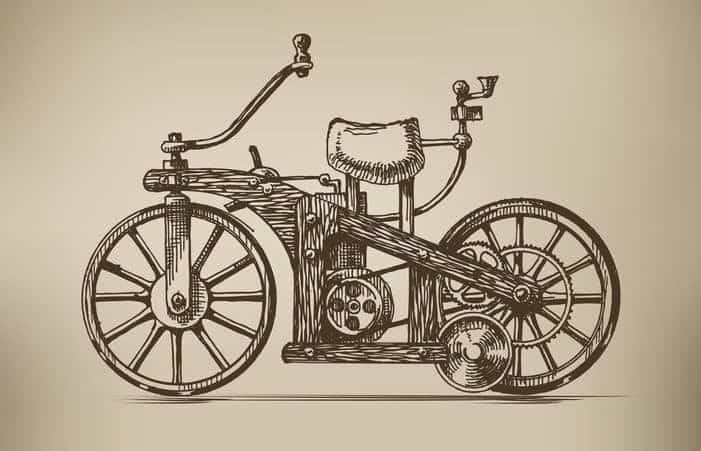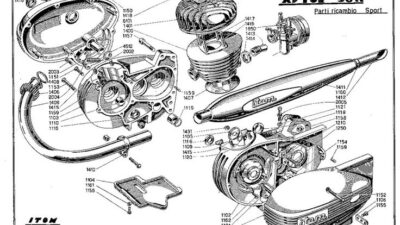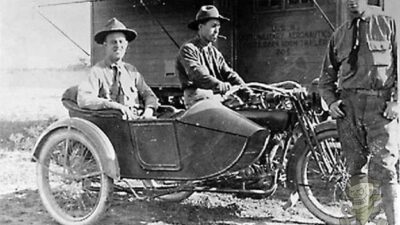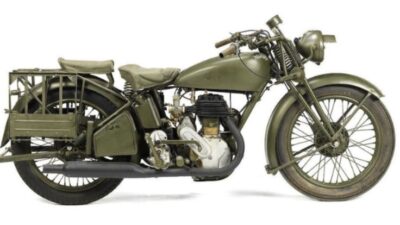In 1885, two German engineers changed transportation forever when they built a strange-looking machine in a garden shed behind a house in Cannstatt. Gottlieb Daimler and Wilhelm Maybach never set out to invent the motorcycle. They simply wanted to test their new high-speed gasoline engine.

The Daimler Reitwagen became the world’s first gasoline-powered motorcycle, earning Daimler the title “father of the motorcycle.” This wooden-framed vehicle with iron wheels and training wheels looked more like a torture device than modern transportation. Yet it proved that small gasoline engines could power personal vehicles.
The machine reached only 6.8 mph and caught fire on its maiden voyage when Daimler’s 17-year-old son Paul rode it from Cannstatt to Untertürkheim. Despite these problems, the Reitwagen started a revolution that led to every motorcycle, car, and airplane that followed. The engine design they created became the foundation for nearly all motor vehicles we use today.
Key Takeaways
- Gottlieb Daimler and Wilhelm Maybach created the first gasoline-powered motorcycle in 1885 as a test vehicle for their new engine design.
- The Daimler Reitwagen proved that small internal combustion engines could successfully power personal transportation vehicles.
- This invention became the foundation for all modern motorcycles and influenced the development of cars and aircraft engines.
Gottlieb Daimler’s Vision and Early Engineering

Gottlieb Wilhelm Daimler was born on March 17, 1834, in Schorndorf, Germany. From his early years, he showed a keen interest in machines and mechanics.
Daimler pursued his engineering education at the Stuttgart Polytechnic Institute. This gave him a strong foundation in engineering principles that would shape his future work.
Early Career Path:
- Worked at various machine shops
- Gained experience at multiple engineering firms
- Built practical skills through hands-on work
After completing his studies, Daimler worked in various German engineering firms. He spent time gaining valuable experience with engines and mechanical systems.
His vision focused on creating small, high-speed engines. Daimler believed these compact power sources could revolutionize transportation. He wanted to move beyond the large, slow engines that dominated the market.
Daimler formed a crucial partnership with Wilhelm Maybach early in his career. The two engineers shared the same dream of developing advanced internal combustion technology.
In 1883, Daimler received a patent for a lightweight gasoline combustion engine. This engine included a glow tube-type ignition system.
| Key Innovation | Year | Impact |
|---|---|---|
| Lightweight gas engine | 1883 | Foundation for mobile vehicles |
| High-speed design | 1883 | Enabled practical transportation |
His engineering approach emphasized speed and efficiency over raw power. This thinking would prove essential for creating the first gasoline motorcycle.
Collaboration with Wilhelm Maybach

Gottlieb Daimler’s partnership with Wilhelm Maybach proved crucial in developing the first gasoline-powered motorcycle. Their combined expertise in mechanical engineering and engine design led to breakthroughs that would revolutionize transportation.
Innovative Partnership in Engine Design
Daimler and Maybach first worked together at N.A. Otto & Cie, where Daimler became director in 1872. The company was the world’s largest engine manufacturer at the time.
Their collaboration produced significant advances in internal combustion technology. In 1876, they helped create Otto’s compressed charge gaseous petroleum engine. This success led to the company being renamed Gasmotoren Fabrik Deutz.
When Otto showed no interest in making engines small enough for transportation, Daimler left Deutz and took Maybach with him. They moved to Cannstatt to work on a “high speed explosion engine.”
The partnership achieved their goal in 1883 with a horizontal cylinder engine running on petroleum naptha. Otto engines could only reach 150-200 rpm and couldn’t be throttled. Daimler and Maybach aimed for 600 rpm minimum to power various transportation equipment.
Transition from Steam to Gasoline Power
The duo developed their vertical cylinder model in 1884, nicknamed the “Grandfather Clock engine.” This engine achieved 700 rpm and soon reached 900 rpm. The breakthrough came from using Hot-Tube ignition developed by an Englishman named Watson.
Steam-powered motorcycles already existed before their work. The Michaux-Perreaux and Roper from 1867-1869, plus the 1884 Copeland, preceded the Reitwagen. However, these steam engines proved impractical for widespread use.
Daimler and Maybach’s 1885 engine became the prototype of the modern gas engine. Their compact, lightweight design made gasoline power viable for motorcycles.
The engine featured a float metered carburetor and mushroom intake valves. It used hot tube ignition instead of electrical systems, which were unreliable at high speeds. Twin flywheels and an aluminum crankcase completed the revolutionary design.
The Creation of the Daimler Reitwagen

Daimler and Maybach patented their revolutionary motorcycle design on August 29, 1885, featuring a single-cylinder engine that produced 0.5 horsepower. The first motorcycle test ride occurred on November 18, 1885, when Daimler’s 17-year-old son Paul rode the machine from Cannstatt to Untertürkheim.
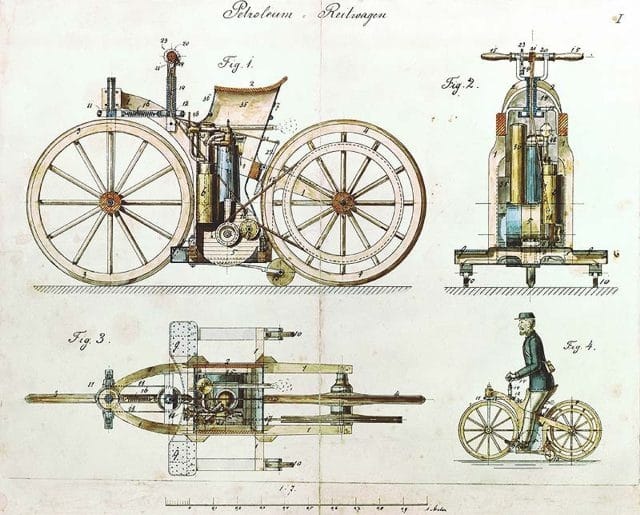
Patent and Design Features
The Reitwagen featured a 264-cubic-centimeter single-cylinder engine mounted on rubber blocks to reduce vibration. The engine used hot tube ignition instead of electrical systems, which were unreliable at the time.
Key Design Elements:
- Wooden frame construction
- Iron-rimmed wooden wheels
- Two spring-loaded outrigger wheels for stability
- Belt drive transmission system
- Twist grip handlebar controls
The motorcycle weighed 200 pounds and could reach speeds of 6.8 mph. Its engine operated at 600 rpm, much faster than other engines of the era.
The original design included complex steering linkage with right-angle bends and gears. However, the working model used simple handlebars without the twist grip controls shown in the patent drawings.
Paul Daimler’s Historic First Ride
Paul Daimler became the world’s first motorcycle rider when he tested the Reitwagen on November 18, 1885. He rode the machine for 3 to 7 miles between Cannstatt and Untertürkheim, Germany.
The test ride revealed immediate problems with the design. The seat caught fire during the journey because the hot tube ignition was positioned directly underneath it.
Despite this setback, the ride proved that a gasoline-powered two-wheeled vehicle could work. Paul’s successful test demonstrated the practical potential of internal combustion engines for personal transportation.
The fire incident led Daimler and Maybach to redesign the ignition system placement. They moved the hot tube away from combustible materials for safer operation.
Testing the Grandfather Clock Engine
Daimler and Maybach developed their “grandfather clock engine” in 1884 before installing it in the Reitwagen. The vertical cylinder design achieved 700 rpm and later reached 900 rpm, far exceeding contemporary engine speeds.
The engine used a float-metered carburetor and mushroom intake valves. These valves opened automatically from the suction created during the piston’s intake stroke.
Engine Specifications:
- Power output: 0.37 kW (0.5 hp)
- Operating speed: 600-900 rpm
- Bore and stroke: 58mm × 100mm
- Fuel: Petroleum naphtha or coal gas
Hot tube ignition used a platinum tube heated by an external flame. This system provided reliable ignition at high engine speeds when electrical systems could not.
The engine featured twin flywheels and an aluminum crankcase. These components helped smooth operation and reduced overall weight compared to iron construction.
Technical Aspects of the First Gasoline Motorcycle

The Daimler Reitwagen featured groundbreaking technical innovations that set it apart from earlier steam-powered motorcycles. Its internal combustion engine, wooden frame design, and primitive ignition system established the foundation for modern motorcycle development.
Internal Combustion Engine Development
Gottlieb Daimler and Wilhelm Maybach built their motorcycle around a revolutionary single-cylinder engine. The first gasoline-powered internal combustion engine produced 0.5 horsepower at 700 rpm.
The engine used a four-stroke design based on Nicolaus Otto’s work. It featured a vertical cylinder with a displacement of approximately 264 cubic centimeters.
Key Engine Specifications:
- Power Output: 0.5 hp (0.37 kW)
- RPM: 700 maximum
- Cylinders: Single vertical cylinder
- Displacement: ~264cc
The engine earned the nickname “grandfather clock engine” due to its tall, narrow appearance. This compact design allowed it to fit within the motorcycle’s wooden frame structure.
Air cooling kept the engine temperature stable during operation. The simple design used minimal moving parts, making it relatively reliable for 1885 technology.
Frame Structure and Stability Solutions
The Daimler Reitwagen used a wooden frame constructed from ash wood. This lightweight material provided adequate strength while keeping the overall weight manageable.
Two small outrigger wheels attached to the sides prevented the motorcycle from tipping over. These training wheels solved the stability problem that plagued early two-wheeled vehicles.
The front wheel measured 28 inches in diameter. The rear wheel was slightly smaller at 24 inches, both featuring iron-shod wooden construction.
Frame Components:
- Wooden ash construction
- Two side-mounted outrigger wheels
- Iron-reinforced joints
- Total weight: approximately 110 pounds
The seat positioned the rider upright, similar to a bicycle. Handlebars provided steering control through a simple mechanical linkage to the front wheel.
Ignition System and Fuel Innovations
The Reitwagen used a hot tube ignition system instead of electric spark plugs. A platinum tube heated by an open flame ignited the fuel-air mixture in the cylinder.
This ignition method required constant attention to maintain the proper flame temperature. The rider had to monitor the flame throughout the journey to ensure reliable engine operation.
Ignition System Features:
- Hot platinum tube design
- Open flame heat source
- Manual flame adjustment
- No electrical components required
The fuel system consisted of a simple carburetor that mixed gasoline with air. Gasoline stored in a small tank fed the engine through gravity flow.
The gasoline-driven design gave the Reitwagen credibility as the first true motorcycle. Earlier motorcycles relied on steam power, which required heavy boilers and water supplies.
Performance Capabilities
The Daimler Reitwagen achieved a top speed of approximately 7 miles per hour. This modest performance exceeded the walking pace of 3-4 mph but remained slower than a horse.
Adolf Daimler completed the first motorcycle ride on November 10, 1885. He traveled from Cannstatt to Untertürkheim, covering about 3 kilometers.
The motorcycle’s range depended on its small fuel tank capacity. Typical rides lasted 30-45 minutes before requiring refueling and flame adjustment.
Performance Specifications:
- Top Speed: ~7 mph (11 km/h)
- Range: 30-45 minutes continuous operation
- Fuel Consumption: High due to primitive carburation
- Reliability: Required frequent maintenance stops
The engine’s low power output limited hill-climbing ability. Riders often had to dismount and push the motorcycle up steep inclines.
Starting the engine required manual cranking while maintaining the ignition flame. This process took several minutes and required mechanical knowledge to execute properly.
Impact on the Evolution of Motorcycles

The Daimler Reitwagen revolutionized motorcycles by incorporating an internal combustion engine in 1885, establishing the foundation for all future gasoline-powered motorcycles. This breakthrough provided the blueprint that manufacturers would follow for decades and marked the shift from steam power to practical motorized transportation.
Inspiration for Later Motorcycle Inventors
The Reitwagen served as the primary model for early motorcycle pioneers worldwide. Its basic design principles influenced manufacturers throughout the late 1800s and early 1900s.
The vertical cylinder engine layout that Daimler and Maybach created became the standard configuration. Many early inventors copied this design because it provided better balance and stability than horizontal engines.
The wooden frame construction method was adopted by numerous manufacturers until metal frames became more affordable. This approach allowed smaller workshops to build motorcycles using readily available materials and traditional woodworking skills.
Key design elements that influenced later motorcycles:
- Single-cylinder gasoline engine placement
- Vertical engine orientation
- Basic throttle and ignition controls
- Two-wheel configuration with stabilizing wheels
The carburetor system developed for the Reitwagen became the foundation for fuel delivery in motorcycles for nearly a century. This technology remained largely unchanged until electronic fuel injection systems appeared in the 1980s.
Comparison to Steam-Powered Predecessors
Steam-powered motorcycles existed before 1885 but had significant limitations that the Reitwagen solved. The gasoline engine offered practical advantages that made motorcycles viable for everyday use.
Steam vs. Gasoline Power Comparison:
| Feature | Steam Power | Gasoline Power |
|---|---|---|
| Startup time | 15-30 minutes | Immediate |
| Weight | Very heavy | Lighter |
| Range | Limited by water | Extended |
| Maintenance | Complex boiler care | Simple engine care |
The Reitwagen achieved greater speed and efficiency than steam-powered counterparts. Steam motorcycles required water refills and lengthy heating periods before operation.
Gasoline engines eliminated the need for heavy boilers and water tanks. This weight reduction improved handling and made motorcycles more maneuverable for riders.
The instant-start capability of gasoline engines made motorcycles practical for short trips. Steam versions were only suitable for planned, longer journeys due to startup requirements.
Transition to Commercial Production
The Reitwagen’s success demonstrated the commercial potential of gasoline motorcycles. By 1894, Hildebrand & Wolfmüller produced the first mass-produced motorcycles with gasoline engines.
Early manufacturers studied Daimler’s engine design to develop their own production models. The basic internal combustion principles established by the Reitwagen guided industrial motorcycle development.
Timeline of Commercial Development:
- 1885: Daimler Reitwagen prototype completed
- 1888: Daimler Petroleum Reitwagen improved version
- 1894: First mass-produced gasoline motorcycles
- 1900s: Multiple manufacturers enter market
The transition from prototype to production required refinements in manufacturing processes. Companies adapted Daimler’s designs for assembly line production, making motorcycles affordable for more consumers.
Metal frames gradually replaced wooden construction as production volumes increased. This change improved durability and allowed for more precise manufacturing tolerances.
Engine improvements followed Daimler’s original design but incorporated better materials and manufacturing techniques. These advances increased reliability and performance while reducing production costs.
Gottlieb Daimler’s Broader Automotive Influence

Daimler’s work extended far beyond his first motorcycle invention, establishing one of the world’s most important automotive companies and creating lasting innovations that shaped modern transportation. His founding of the Daimler company and technological breakthroughs influenced both car and motorcycle industries for generations.
Founding of Daimler-Benz
Gottlieb Daimler established the Daimler Motoren-Gesellschaft in 1890 to build engines based on his designs. This company became the foundation for modern automotive manufacturing in Germany.
The company focused on producing high-quality gasoline engines for various vehicles. Daimler and his partner Wilhelm Maybach continued developing their engine technology within this business structure.
After Daimler’s death in 1900, the company evolved and eventually merged with Karl Benz’s company in 1926. This merger created Daimler-Benz AG, which became famous for producing Mercedes-Benz vehicles.
The original Daimler company’s engineering principles and quality standards remained central to the merged organization. These standards helped establish Mercedes-Benz as a premium automotive brand that continues today.
Legacy in the Automotive and Motorcycle Industries
Daimler and Maybach invented the first V-shaped, two-cylinder, four-stroke engine, which became the foundation for modern automobile engines. This engine design solved key problems with earlier internal combustion engines.
Their innovations included creating compact, lightweight engines that could power various vehicles effectively. The high-speed gasoline engine they developed made practical automobiles possible.
Daimler’s 1885 motorcycle represented the first successful application of gasoline power to two-wheeled transportation. This breakthrough proved that internal combustion engines could work in small, mobile applications.
The motorcycle industry adopted many of Daimler’s engine principles. Modern motorcycle engines still use variations of the four-stroke cycle and ignition systems he helped develop.
His work influenced automotive manufacturing methods and engine technology worldwide. Companies across Europe and America studied and adapted Daimler’s innovations for their own vehicle production.
Frequently Asked Questions

The Daimler Reitwagen featured specific technical elements that made it groundbreaking for its time. The collaboration between Gottlieb Daimler and Wilhelm Maybach created lasting impacts on motorcycle and automotive development.
What were the key features of the Daimler Reitwagen?
The Daimler Reitwagen featured a gasoline engine mounted on a wooden frame. It had two main wheels with two smaller outrigger wheels for stability, similar to training wheels on children’s bikes.
The motorcycle used Daimler’s first four-cycle, single-cylinder engine that produced half a horsepower. The engine ran on petroleum fuel through a carburetor system.
The frame was constructed primarily of wood. The design included a saddle for the rider positioned between the two main wheels.
How did Gottlieb Daimler’s invention contribute to future motorcycle designs?
Daimler’s first motorcycle invention changed transportation forever by establishing the basic concept of a motorized two-wheeler. His design showed that internal combustion engines could power personal vehicles.
The Reitwagen proved that gasoline engines were practical for transportation. This demonstration encouraged other inventors to develop improved motorcycle designs.
Future motorcycles adopted Daimler’s core concept of combining an internal combustion engine with a bicycle-like frame. Modern motorcycles still use this basic principle today.
What was the original selling price of the Daimler Reitwagen when it first came out?
The Daimler Reitwagen was not sold commercially when it was first built in 1885. Daimler and Maybach created it as a test vehicle for their new engine technology.
The motorcycle served as a prototype to demonstrate their engine’s capabilities. They used it to show that their internal combustion engine could power vehicles.
Daimler focused on licensing his engine technology to other manufacturers rather than mass-producing motorcycles. The Reitwagen remained a one-off experimental vehicle.
Who was Wilhelm Maybach and what was his role in the development of the first gasoline motorcycle?
Wilhelm Maybach was Gottlieb Daimler’s coworker who helped develop the high-speed internal combustion engine. He worked closely with Daimler on all aspects of the motorcycle project.
Maybach and Daimler spent ten years developing their practical gasoline-powered engine before fitting it to the motorcycle in 1885. Maybach contributed technical expertise in engine design and construction.
The two men left their previous employer together in 1882 to start their own engine-building business. Maybach’s engineering skills were essential to creating the Reitwagen.
How did the partnership between Gottlieb Daimler and Wilhelm Maybach influence the automotive industry?
Daimler and Maybach’s partnership produced innovations that became standard in the automotive industry. Their carburetor design made gasoline engines practical for vehicles.
They patented one of the first successful high-speed internal-combustion engines that other manufacturers could use. This engine technology became the foundation for early automobiles.
Their work proved that internal combustion engines were superior to steam power for vehicles. This demonstration helped establish gasoline engines as the preferred automotive technology.
What were the technical specifications and performance capabilities of the Daimler Reitwagen?
The Reitwagen used a single-cylinder, four-cycle engine that produced half a horsepower. The engine operated at higher speeds than previous designs of the time.
The motorcycle had a wooden frame with iron-shod wooden wheels. It measured approximately 10 feet long and weighed around 200 pounds.
The top speed reached about 7 miles per hour on flat ground. The engine could run for several miles before needing fuel or maintenance stops.
